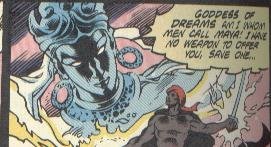
MAYA
Real Name: Maya

Identity/Class: Mystically-Altered human
Occupation: Goddess of Dreams, former Queen of the Sakyas (c. 560? BC)
Affiliations: Hindu Gods (Daevas)
Enemies: British Empire
Known Relatives: Siddhartha (son, alias Gautama Buddha)
Aliases: Mahadevi (she was sometimes equated with the goddess Lakshmi Sri)
Base of Operations: Nirvana, formerly Kapilavastu, India in the Sixth Century BC (now part of modern Nepal),
First Appearance: Amazing High Adventure#5 (December 1986)
Powers/Abilities: Maya possesses the conventional powers of the Hindu gods possibly including superhuman strength (Class 25), longevity, resistance to injury and several powers mystical in nature, possibly to stir visions and images in the form of dreams to mortals.
History: (Hinduist Legend) Maya was once the queen of the Sakya warrior caste of Ancient India. In a dream, the Hindu god Vishnu appeared to her in the form of a bodhisattva and informed her that she would have a son. Her son, Gautama Buddha, was actually Vishnu in his ninth avatar on earth and in this form he became an Indian philosopher whose preachings became the religious tenets that became modern Buddhism .
Under unresolved circumstances, Maya was accepted as a god into the Hindu Pantheon. Her importance was much more felt to Chinese Buddhists.
(Amazing High Adventure#5/3) <1870's> An Indian rebel called the Mahdi, seeking to destroy the British army, prayed to the Hindu gods, demanding the power to fight the British. In a vision, Yama, Ratri (goddess of night), Agni (god of fire, two-headed), Maya (goddess of dreams), and Kali granted the Mahdi powers and weapons to fight the British. From Yama, the Mahdi gained a fiery sword, from Ratri the power of "the night's shadows", from Agni sacrificial flame, from Maya the power to drive his enemies to despair with illusions, and from Kali the wheel of destruction. The Mahdi then used these powers in battle-only to discover too late that he had offended the gods by trying to order them around. The Mahdi's weapons were only illusions, and he died in battle.
Comments: Adapted by Bill Mantlo and Steve Purcell.
This entry obviously employs many of the characteristics of both Hinduism and Buddhism. It might be added that Buddha's birth in the Sixth Century BC is topical.
For more on Hinduism and Marvel comics, please refer to the discussions under Shiva's entry.
Some observations from Theravada Buddhism practicioner Luis Dantas: The relationship between the beliefs of the Sanatana Dharma (a.k.a. Hinduism) and those of the Buddha Dharma (a.k.a. Buddhism) is not the easiest one to understand or summarize, not in the least because neither religion has much of an unified view about their deities to begin with. There is also the matter that both religions share lots of concepts but define them in different ways, and do not really resemble each other much as far as actual doctrine goes. Most Sanatana Dharmi (hinduists) tend to see the Buddha as Lord Krishna's successor and the ninth emanation (avatar) of Vishnu (as mentioned in the Vishnu profile), and Buddhism itself as a means of bringing the Sanatana Dharma to those (such as atheists) who otherwise would not accept the Devas. By contrast, many (not all) buddhists tend to see all supernatural beings as somewhat symbolic in nature and do not emphasize their historical links to the Sanatana Dharma a lot - so much so that Buddhism mixed fairly well with Taoism in China, with the Bön belief in Tibet and with Shinto in Japan, bringing lots of new buddhist schools into existence. In Buddhist canon, Queen Maya is the mother of Gautama, the historical Buddha. There is some reference to the Hindu Devas, but not much emphasis on them. Nor is there any consensus about how literal the existence of the Devas or their role in Buddhist Cosmology is. As a matter of fact traditional buddhism is very much oriented to developing constructive mental states and behavior and brings the very existence of separate beings (both common people and deities) to question. I talked a bit about this matter in the Virus profile. Anyway, it is generally understood in Buddhist practice that Maya, the mother of Gautama Buddha, is not literally Maya the Devi even if both are indeed present in Buddhist canon. Digha Nikaya 20, the Maha-samaya Sutta among other canonic texts has a reference to Maya Devi. The naming of Buddha's mother as "Maya" (illusion) may well be a symbolic reference, much as Buddha's son is named "Rahula" (fetter). Even Nirvana is not usually considered to be an actual place or dimension but rather a result of our actions when we eventually reach enlightenment. So this profile would (from a Buddhist viewpoint) refer to Maya the Mahadevi, not to Queen Maya mother of Gautama Buddha, who probably has never been seen in a Marvel comic yet. For more real world ™ information on Hinduism and Buddhism I highly recommend the specific pages of the OCRT. Specifically about Maya I suggest this excellent reference.
CLARIFICATIONS: Maya is not to be confused
with:
Atar, also called Agni, should not be confused with:
Kali is the namesake for, but should be distinguished from:
Ratri should not be confused with:
Yama should not be confused with:
PROFILE BY: Thor2000 and Per Degaton
Last updated:
12/21/03
Any Additions/Corrections? please
let
me know.
Non-Marvel
Copyright info
All other characters mentioned or pictured are ™ and © 1941-2099
Marvel Characters, Inc. All Rights Reserved. If you like this stuff, you
should check out the real thing!
Please visit The Marvel Official Site at:
http://www.marvel.com